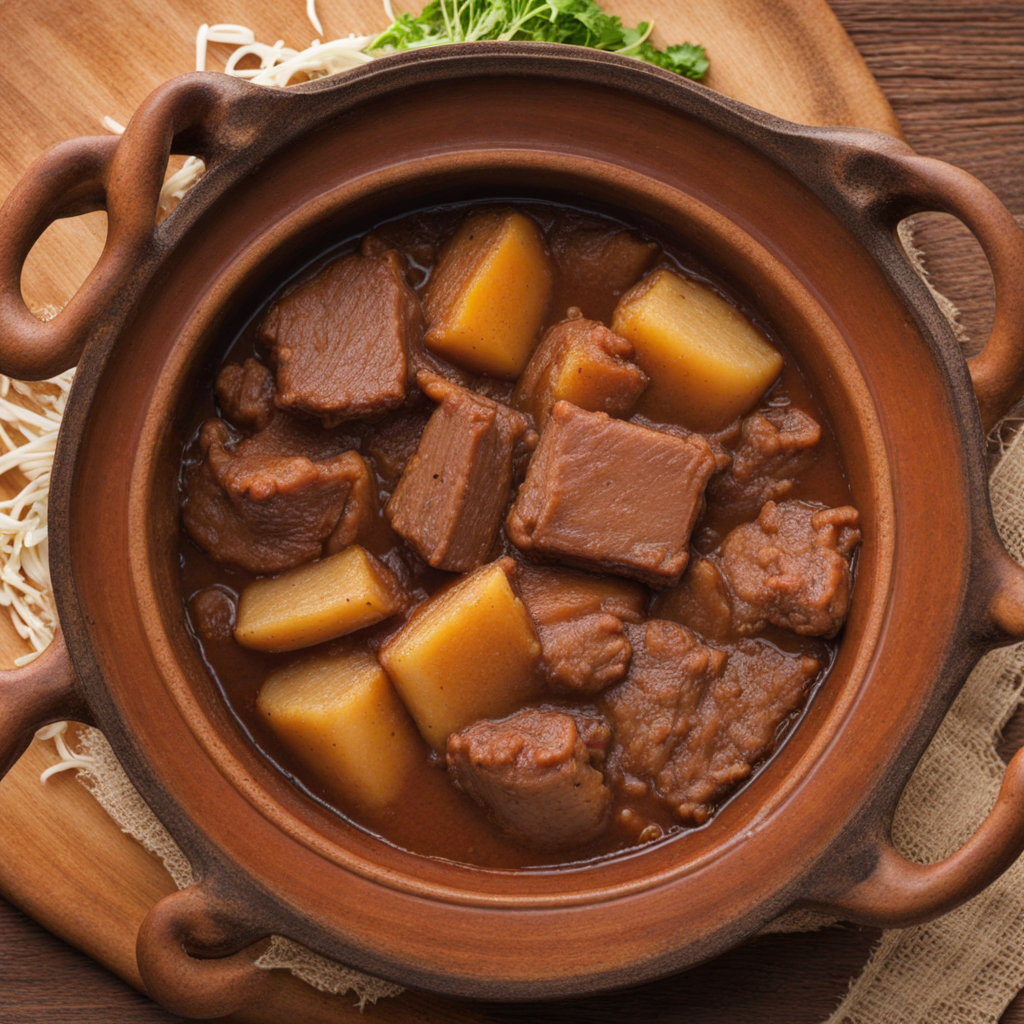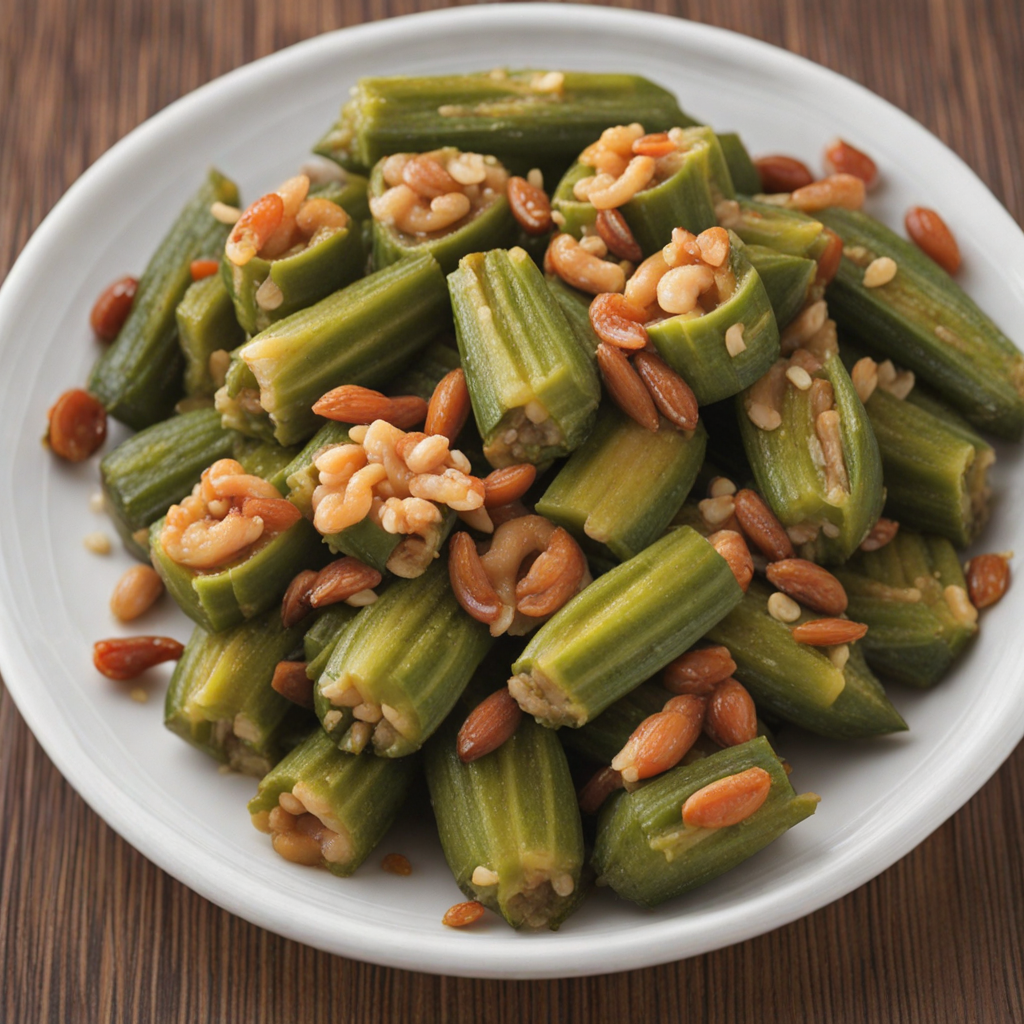Quindim
Quindim is a delightful Brazilian dessert that captures the essence of coconut and egg in a vibrant, yellow treat. Its origins are rooted in Portuguese cuisine, but it has evolved into a beloved staple in Brazil. The dessert is primarily made from a simple blend of egg yolks, sugar, grated coconut, and butter, creating a rich and creamy texture that melts in your mouth. The glossy top, often resembling a golden custard, is achieved through careful baking, resulting in a visually appealing dish that is as enticing as it is delicious. As you take your first bite, the sweet, luscious flavor of coconut immediately envelops your palate, balanced by the richness of the egg yolks. The combination of the crunchy coconut flakes and the smooth custard-like base creates a delightful contrast in textures. Quindim is typically served in small, round portions, making it easy to indulge in this sweet treat without feeling overwhelmed. Its petite size is perfect for sharing or enjoying as a personal indulgence after a meal. What makes Quindim truly special is its versatility; while the traditional recipe remains a classic favorite, variations abound. Some adventurous bakers experiment by incorporating flavors like lime or passion fruit to add a tropical twist. Regardless of the variation, Quindim remains a celebration of Brazil's rich culinary heritage and is sure to excite the taste buds of anyone looking to discover a new, exotic dessert. Whether enjoyed at a local Brazilian bakery or made at home, Quindim is a unique taste experience that transports you to the vibrant streets of Brazil with every bite.
How It Became This Dish
The Sweet Journey of Quindim: A Brazilian Culinary Delight Quindim is a vibrant and luscious dessert that encapsulates the essence of Brazilian cuisine. This sweet treat, with its bright yellow hue and glossy surface, is made primarily from coconut, sugar, egg yolks, and butter. Its origins are steeped in the intermingling of cultures, traditions, and local ingredients, making it a unique symbol of Brazil’s rich culinary heritage. #### Origins: A Fusion of Cultures The story of quindim begins in the colonial era of Brazil, a time marked by the confluence of Indigenous, African, and Portuguese influences. The arrival of the Portuguese in the 16th century introduced new cooking techniques and ingredients to the Brazilian landscape. The Portuguese had a long tradition of using eggs in desserts, a culinary legacy that can still be seen in many traditional sweets from Portugal. As sugar cane plantations flourished in Brazil, sugar became a staple in Brazilian desserts. At the same time, coconut, an abundant tropical fruit, was embraced by the local population. The combination of these elements—coconut, sugar, and egg yolks—gave birth to quindim. While the exact origins of the name “quindim” are somewhat murky, it is believed to derive from the African word “kinda,” referring to a small quantity or a little thing, reflecting the dessert's small, round shape. #### Cultural Significance: A Symbol of Celebration Quindim quickly gained popularity in Brazilian society, especially in the northeastern region, where coconut is a key ingredient in many local dishes. The dessert became a staple at celebrations, including weddings, religious festivals, and family gatherings. Its bright yellow color symbolizes joy and happiness, making it a fitting addition to festive occasions. In many Brazilian households, quindim is not just a dessert; it is a cherished tradition passed down through generations. Recipes vary from family to family, each adding their own twist, whether through the addition of flavors like vanilla or a hint of lime zest. The dessert is often served in small, fluted molds, creating individual portions that are not only aesthetically pleasing but also easy to share among guests. Quindim has also found its place in Brazilian literature and art. It has been referenced in various works, signifying its deep connection to Brazilian identity. The dessert reflects the country’s diversity, showcasing the blending of Indigenous, African, and European culinary traditions. #### The Evolution of Quindim As Brazil modernized and globalized, quindim evolved alongside changing tastes and dietary preferences. In the early 20th century, quindim became more widely recognized beyond regional boundaries. With the rise of Brazilian tourism, the dessert began to capture the attention of both locals and international visitors, further solidifying its status as a national culinary treasure. In contemporary times, quindim has experienced a renaissance, reimagined by innovative chefs who incorporate it into their modern dessert menus. While traditional recipes remain popular, variations have emerged. Some chefs experiment with different types of coconut, while others add unexpected ingredients like chocolate or fruit to create fusion desserts. These adaptations not only honor the traditional roots of quindim but also make it relevant to today’s culinary landscape. The dessert has also found a place in social media, where visually appealing food is shared and celebrated. Quindim’s bright yellow color and glossy finish make it a perfect candidate for Instagram, allowing it to reach a wider audience and gain new admirers. The hashtag #quindim has become a popular search term, showcasing the dessert's aesthetic appeal and encouraging home cooks to try their hand at making it. #### Making Quindim: A Culinary Art Form The process of making quindim is an art in itself, requiring a careful balance of ingredients and technique. The key to a perfect quindim lies in the quality of the coconut and the method of preparation. Freshly grated coconut is preferred for its flavor and texture, although desiccated coconut is often used in modern recipes for convenience. To prepare quindim, the coconut is mixed with sugar and egg yolks, creating a batter that is both rich and creamy. The mixture is poured into individual molds, which are often greased with butter to ensure easy removal after baking. The molds are then placed in a water bath, which helps to gently cook the quindim, resulting in a smooth, custard-like texture. After baking, the quindim is cooled, allowing it to set before being unmolded. The final product is a glossy, golden treat that boasts a subtle sweetness and an unmistakable coconut flavor. It can be served chilled or at room temperature, often accompanied by a cup of strong Brazilian coffee, creating a delightful contrast of flavors. #### Quindim in the Global Context As globalization continues to influence culinary practices, quindim has started to make its way onto international dessert menus. Chefs around the world are exploring Brazilian cuisine and incorporating traditional dishes into their culinary repertoires. Quindim, with its unique flavor profile and appealing presentation, has become a sought-after delicacy in diverse gastronomic settings. Food festivals celebrating Brazilian culture often feature quindim, allowing attendees to experience the dessert firsthand. This exposure has helped to elevate quindim’s status beyond a regional delicacy, showcasing it as an integral part of Brazil’s culinary narrative. #### Conclusion: A Timeless Treasure Quindim is more than just a dessert; it is a representation of Brazil’s rich cultural tapestry, woven from the threads of Indigenous, African, and Portuguese influences. Its bright color and delicious flavor bring joy to those who enjoy it, making it a beloved treat in Brazil and beyond. As it continues to evolve, quindim remains a testament to the country’s culinary creativity and adaptability, ensuring its place in the hearts and kitchens of many for generations to come. Whether served at a grand celebration or enjoyed with a simple cup of coffee, quindim captures the spirit of Brazil, inviting all to savor its sweetness and history.
You may like
Discover local flavors from Brazil







